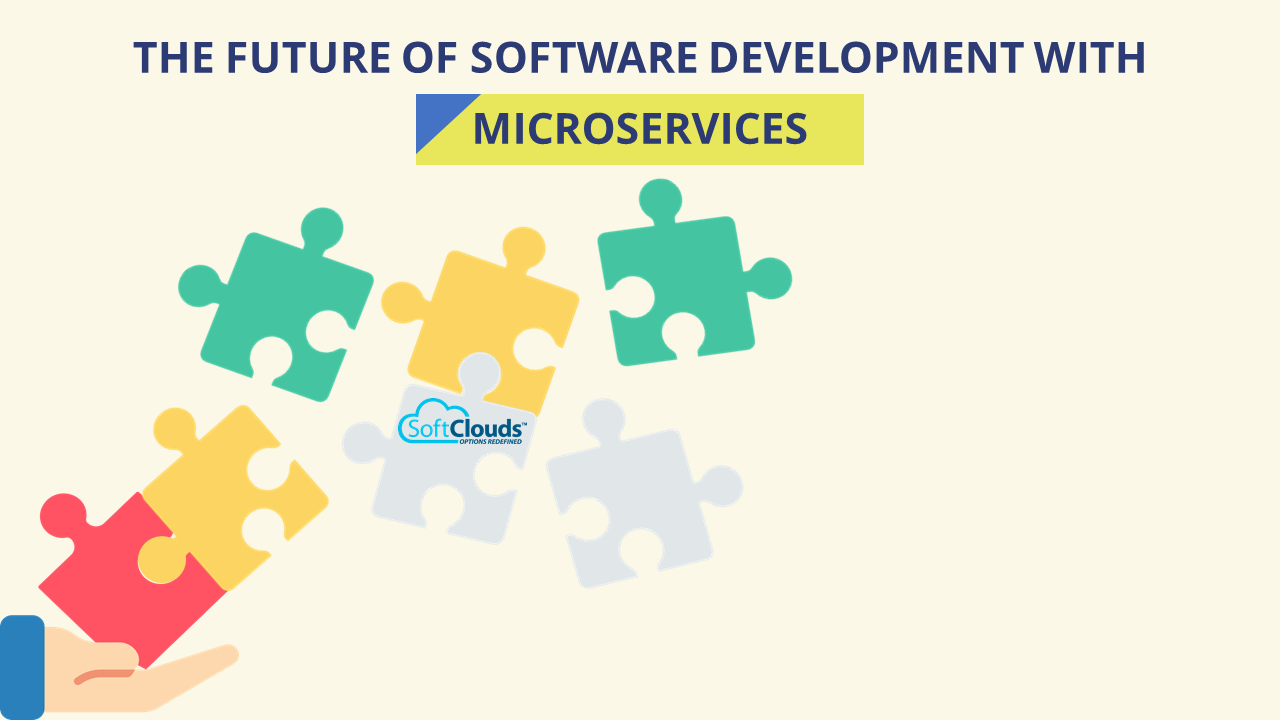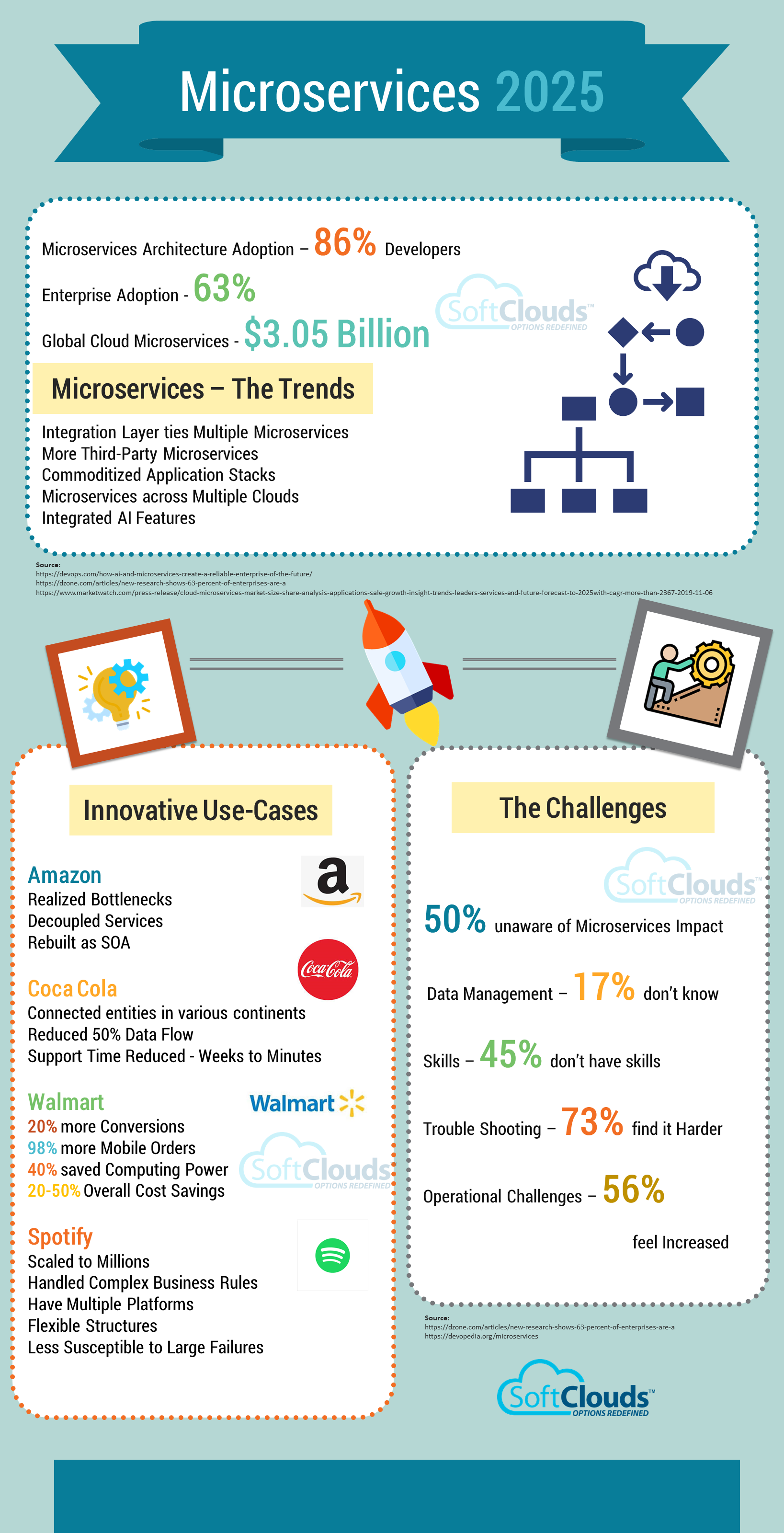The Future of Software Development with Microservices

We are living in an era when the software is eating the world. Global IT spending has already reached a total of $3.7 Trillion in 2019. Market revenues are expected to reach $560 Billion by 2021. The trend of rapid expansion of software will continue to boom in the coming years.
Traditional software and hardware providers are repositioning their products for intelligent productivity and efficiency. It is not the number of lines of codes that matters, but the continuous stream of updates and quick releases of modifications along with bug fixes.
The idea of continuous integration and development represents a dynamic approach to software development. There are mainly two types of architecture that are being used in software development — Monolithic Architecture and Microservices Architecture.
While monolithic architecture is the traditional way of using a single code base with multiple modules, Microservices architecture, on the other hand, uses loosely coupled multiple services.
There are certain challenges associated with traditional monolithic architecture:
• Over a period of time, a single/group of developers have difficulty in understanding the entire application.
• Developers who roll off the project, and the developers who maintain it, might not be the same. Thus, it becomes difficult for new associates to understand the entire application at once.
• Reuse is limited.
• Reuse of code is through shared libraries (tight-coupling), and it mostly in the same development platform as that of monolithic.
The challenges of monolithic architecture highlight the advantages of the Microservices architecture:
• Adding a new person to the project is much easier since new modules can be taken up by the new resource.
• Since Microservices are exposed over Rest API, there is a high chance that this can be used by other modules irrespective of the technologies used.
• Unused modules can be cleaned up without much hassle.
These advantages have led to a great switch to Microservices architecture.
Adoption of Microservices
Microservices architecture is a method of development where a large application is divided into small modular services. Each of them assists a very specific business goal that increases its agility and scalability. It becomes easy to reuse the code for a new implementation altogether.
The adoption of microservices applications is increasing exponentially — Set to grow more than 23.4%to reach $1.8 Million by 2025.
Here are some fundamental notes on the Monolithic and Microservices Architecture:
Monolithic Architecture
• All the processes are closely linked & operate as a single service.
• Everything runs through the same application, so it’s easy to hook up components to those cross-cutting concerns.
• Shared-memory access is a performance advantage.
• If any process reaches a surge of demand, the whole architecture must be scaled.
Microservices Architecture
• Microservices are independently maintainable, testable, and deployable. The loose coupling makes them faster and easier to maintain.
• An application is divided into multiple independent modules that communicate through a well-defined interface using lightweight APIs.
• Standalone functionalities allow a complex design to be organized around specific business needs.
• As a company grows and evolves its tech stack, Microservices allow seamless integration of new features.
Microservices — Types
There are two types of Microservices:
1. Differential: Microservices architecture decomposes into self-encapsulated services, which can break into different transactions. This means a local transaction is distributed into multiple services.
2. Integral: Microservices applications weave multiple atomic microservices into holistic user experiences. It addresses on-demand provisioning, dynamic composition, and service level management.
Microservices — Advantages
Here are some unique advantages which set Microservices apart from other architecture styles:
• Autonomous: Each component of service in a Microservices architecture can be developed, deployed, operated, and scaled without affecting the functionality of other services.
• Specialized: EEach service is built with a set of capabilities and focuses on solving a specific problem. Over time, if it scales, the service can be further bifurcated into smaller services. It helps teams to measure the size of infrastructure needs, the value of a product, and sustain reliability if the system is facing a surge in demand.
• Resilience: In the Microservices architecture, independence prevails — failure of any service does not affect the entire application.
• Technological Freedom: A Microservices system does not adopt the “one size fits all” strategy. Teams can choose the best tool to address their issues and goals independently.
• Easy Deployment: Microservices allow continuous integration and delivery which makes it easy to try out new concepts or roll back if something goes wrong. The low cost of failure encourages development, promotes software upgrades, and accelerates time-to-market for new features.
Microservices — Disadvantages
Here is a list of some potential pain areas associated with Microservices:
• Complex Communication: Increased interconnections and interdependencies raise complexity and the chance of mismanagement.
• More Resources: ‘More services mean more resources’
Microservices are great for large companies but can be complicated for small companies in terms of resources and implementation.
• Independence: The same independence which acts as an advantage is also a disadvantage. As each service has its own database and transaction management, data consistency becomes difficult..
• Security: Increased inter-service communication results in a security threat for a network hack.

Some Leading Innovative ways to Implement Microservices:
Most companies build their systems using monolithic architecture. They start this way in the initial phase of the project, as it is much faster to set up a monolithic architecture and get the business moving. However, predicting future growth, some of the brands came up with new methods to handle complexity.
Following are some innovative use cases:
1. Amazon
Amazon is among the first companies where microservices took a major role in transforming the whole business. All its services and components were tightly coupled with one another. Hence, all the major code changes were stuck in the deployment pipeline for weeks before customers could use them.
Amazon used microservices to break down the structures into a single application. This simplified and shortened the pipeline allowing developers to realize as to where the bottlenecks were. It helped them rebuild the applications as service-oriented architecture, each with a small team dedicated to one service.
More about Microservices at Amazon here.
2. Coca Cola
Coca Cola’s Global IT group faced a big challenge of connecting all the entities on different continents and supporting their growth. Rapid changes looked impossible due to multiple solutions being implemented globally.
They decided to leverage microservices using the Dev-Ops model and GIT. Coca Cola said they could reduce data flow to their networks by 50% and the time required to scale up to support went down from weeks to minutes.
More about Microservices at Coca Cola here.
3. Netflix
Netflix is also one of the earliest adopters of microservices who have set up their architecture on AWS.
Their transition progressed in steps- first, they moved movie encoding and other non-customer facing applications. Then they decoupled customer-facing elements, like account sign-ups, movie selection, device selection, and configuration.
Today, the Netflix application leverages 500+ microservices and API Gateways that handle over 2 Billion API edge requests daily.
More about Microservices at Netflix here.
4. Spotify
As soon as Spotify entered the market, they grew quite rapidly. It soon started looking for a solution that would support scale to millions of users, multiple platforms and handle complex business rules. Their technology teams found a way to meet these requirements by launching Microservices.
Currently, Spotify is running over 810 services, built flexible structures that are easily scalable and resolve real-world bottlenecks in a short time.
More about Microservices at Spotify here.
5. Walmart
Walmart was not able to handle 6 Million page views per minute in 2005 and was getting impossible for any kind of positive user experience.
Walmart replatformed to a microservices architecture in 2012 and conversions were up by 20% overnight, mobile orders were up by 98% instantly and saved 40% of the computing power and experienced 20–50% cost savings overall.
The Future of Microservices
The adoption of Microservices is so strong that 86% of developers internationally expect it to become the default application architecture within the next five years.
Here are some predictions for the coming years:
• Multiple Microservices: The future of microservices will focus more on the integration layer that ties multiple microservices together. This idea was explored by Microsoft in the past where the applications could be built by linking different APIs and services together.
• Serverless Architecture: Demand for on-demand compute resources and serverless architectures will strengthen. Better tooling for rapidly building and deploying Microservices will eliminate the need for a large upfront investment.
• Function as a Service: The entire application stack will be decentralized. Intelligence-driven microservices with the in-memory computer doing real-time analytics will be the trend.
• Multi-Cloud Environment:One of the most exciting developments in the coming era is the use of microservices across multiple cloud environments which brings added advantage of their specific features. Microservices related to database and information management can utilize Oracle’s cloud environment for better optimization. At the same time, other microservices can benefit from the Amazon S3 for extra storage and archiving, all the while integrating AI-based features and analytics from Azure across the application.
The future of Microservices involves a rapid reduction in the friction for developers and operations and to empower them to build microservices from anywhere, with anyone.
Conclusion:
Microservice is quickly becoming a preferred way of building applications throughout industries. We will have innovative companies using microservices and disruptive technologies to make the product cycle as short and efficient as possible.
Expect to see serverless architecture gaining more traction this year. With cost-efficiency becoming more of a focus in development projects, serverless architecture is simply unrivalled.
However, we would also say that a badly designed microservices approach can lead to “microservice sprawl,” and without that centralized control and discipline, the number of microservices will grow exponentially and create an IT landscape that is complex, difficult to manage, and reduce reuse rather than increase it.
Even then, we still have so many new developments to anticipate. Let us see how microservices will continue to bring big changes.
. . .
. . .
This post was written by Aruna Choragudi, the Practice Director for Java Solutions at SoftClouds. Aruna has over 14+ years of experience with architecting, designing, building and maintaining Java-based products and solutions.
Aruna has extensive experience as an engineer, coach, trainer, leader and transformation engineer managing cross-functional teams using multiple technologies. Aruna has an exceptional background implementing solutions that use various software development methodologies (waterfall, agile, scrum, Kanban, hybrid).
Flexible and results driven, Aruna has expertise in working in distributed global team environments and has a keen-eye to deliver quality results on time. She has extensive experience in designing and developing the most effective enterprise-level technical solutions to meet business requirements. She also is specialized in developing customizations for Oracle CRM & CX Products, and integrations to various micro-services.
. . .
SoftClouds is a recognized leader in CRM/CX transformation with experience in numerous Service Cloud Implementations with pre-configured best practice business processes for multiple verticals/domains.
If you have any questions or would like to find out more about SoftClouds and our extensive experience, you can reach us at “marketing-at-softclouds-dot-com”.